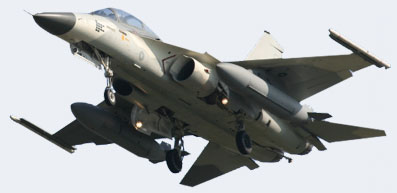IDC F-CK Ching-Kuo
 The AIDC F-CK-1 Ching-kuo is a Chinese-American light fighter aircraft that is used by, and was developed for the Republic of China (Taiwan) Air Force, it entered active service in 1994, with a total of 131 production aircraft manufactured (production ended in 1999).
The AIDC F-CK-1 Ching-kuo is a Chinese-American light fighter aircraft that is used by, and was developed for the Republic of China (Taiwan) Air Force, it entered active service in 1994, with a total of 131 production aircraft manufactured (production ended in 1999).It was developed as the Indigenous Defence Fighter, though it was a joint effort between Taiwanese (ROC) and U.S. Defense companies. As a result many aspects of the aircraft were influenced by F-16 Fighting Falcon, as well as F-5 (also used by the ROC). The major U.S. engineering and development subcontractors were General Dynamics (F-16 designer), Hughes, and Westinghouse Electric Corporation who worked with Taiwanese counter parts. Other parts were directly purchased from Lear Astronics (Later BAE), Litton (Later Northrop Grumman), and Martin-Baker. Final assembly was by the Aerospace Industrial Development Corporation based in Taichung, in ROC.

The IDF program started when purchase of the F-20 Tigershark ran into political problems. The preliminary search for ROCAF's F-5 and F-104 replacement began in the late 1970s. After US established formal relation with People's Republic of China and ended the Mutual Defense Treaty with Taiwan, President Chiang Ching-Kuo decided to expand the indigenous defense industry and ordered AIDC to work on an indigenous high-speed interceptor.
The IDF was designed to counter the PLA's J-8 / J-7 / newer fighters such as J-12, and was intended to have performance on par with the F-16 and Mirage 2000. The greatest difficulties were encountered by the propulsion group in attempting to develop or acquire advanced jet engines suitable for a fighter aircraft. There is also speculation that the use of weaker engines was due to political rather than technical reasons, namely that US did not want to see Taiwan to provoke PLA and thus mandated IDF to have "range no greater than F-5E" and "ground attack capability no greater than F-16".
After IDF's role changed from high-speed interceptor to air superiority fighter at the end of 1982, the engine requirements changed as well. ITEC completely redesigned TFE-1042-7 into TFE-1042-70, for example, bypass ratio was changed from 0.84 to 0.4.
In 1988, ITEC decided to invest in the 12000 lb TFE-1088-12, which was re-designated as TFE-1042-70A. Preliminary study had shown that IDF could supersonic cruise with the new engine. At the same time, GE decided to enter the market with J101/SF, a smaller version of F404. However after the IDF order was cut in half from 250 to 130 in 1992, the TFE-1088-12 engine upgrade plan ended as well. Since then, there are many rumors of AIDC completing engine upgrade research in private, but no direct public announcement of IDF fleet engine upgrade was ever made officially by either ROCAF or AIDC.
Like Tien Lei, the Tien Chien project is shrouded in secrecy. CSIST's Tien Chien is somewhat a more independent plan, since it is considered by some officials to be a development for all ROCAF aircraft rather than IDF only. Tien Chien 1 (TC-1) is a short range IR missile similar to AIM-9 external configuration. Tien Chien 2 (TC-2) is an active radar homing Beyond Visual Ranage missile claimed to be in the AIM-120 class.
The first test firing of TC-1 was made by F-5E in April 1986, with the Beech target drone successfully destroyed. Initial production of TC-1 began in 1989, and entered service in 1991. Both AIM-9 and TC-1 appeared on operational IDFs.
After ROCAF annunced the intention to purchase F-16C/D as a stop gap measure in 2006, media widely reported that existing F-CK-1s would become trainers after new F-16s enter service. In response to a legislator's question in May 2006, Deputy Chief of the General Staff for Operations and Planning, Lt. General Cheng Shih-Yu said that Ministry of Defense indeed plans to retire F-5E/F by 2010 and let IDF to takeover the trainer missions.
General characteristics
Length: 14.21 m (46 ft 7 in)
Wingspan: 9.46 m (31 ft 0 in)
Height: 4.42 m (14 ft 6 in)
Wing area: 24.2 m² (260 ft²)
Empty weight: 6,500 kg (14,300 lb)
Loaded weight: 9,072 kg (20,000 lb)
Max takeoff weight: 12,000 kg (27,000 lb)
Powerplant:
2× TFE1042-70
Dry thrust: 27 kN (6,000 lbf)
Thrust with afterburner: 42 kN (9,500 lbf) each
Performance:
Maximum speed: Mach 1.8
Range: 1,100 km (600 nm, 680 mi)
Service ceiling: 16,800 m (55,000 ft)
Armament:
Guns: 1× 20 mm (0.787 in) M61A1 cannon
Missiles: 2× Sky Sword I , 2× Sky Sword II , Wan Chien cluster bomb
Avionics:
Radar: 1× GD-53 X-band pulse doppler
Effective scanning range:
Look down: 39 km (24 mi)
Look up: 57 km (35 mi)
Links:
www.milavia.net
www.taiwanairpower.org
www.combataircraft.com
Labels: AIDC F-CK Ching-Kuo, aircraft, aviation, Chinese, dreamhost promocode, F-16, F-5, Falcon, Indigenous Defence Fighter, links, Republic of China, Taiwan

